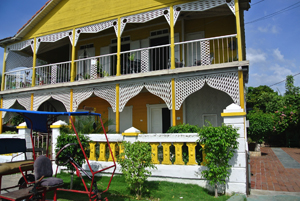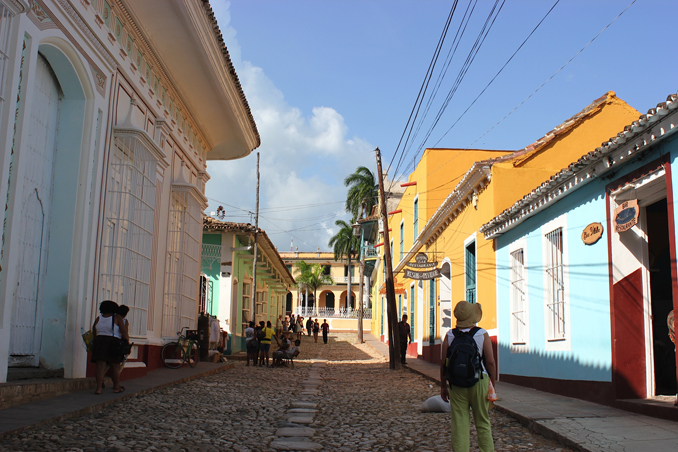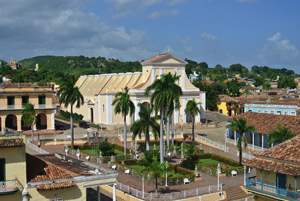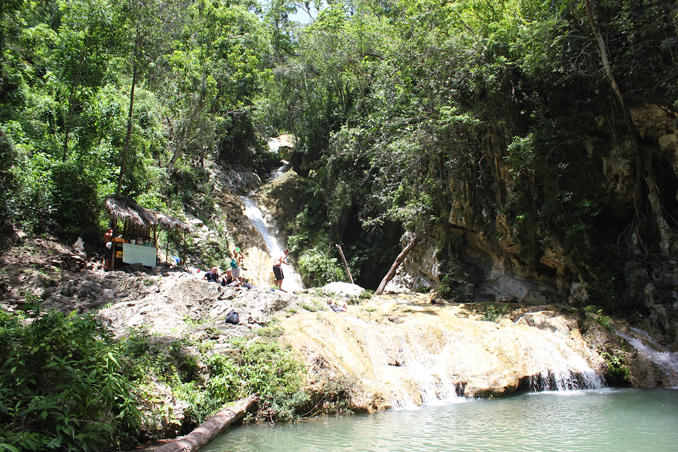Written by: Dr. Dushka H. Saiyid - Posted on: September 23, 2013 |  Comments | 中国 (Chinese)
Comments | 中国 (Chinese)
Google Translation: اُردو | 中文
Within three hours we were in Cienfuegos, a stately town of about 150,000 people, often referred to as “the pearl of the south” with its wide boulevards and elegant but homogenous architecture. It is different from other cities because it was founded and settled by the French, and not the Spanish, in the early 19th century. Located around a natural bay, it has wide, paved roads and elegant neoclassical buildings.
 |
| A house in Cienfuegos |
The city is divided into two parts: the Punta Gorda, a narrow slice of land jutting into the bay, and the historic center, which was declared a World Heritage Site by UNESCO. If you want to hang out in a hammock, look out at the calm waters of the bay and go swimming, then Punta Gorda is the place to stay. It is full of exquisite bungalows, built in the nineteenth century by the sugar cane owning elite.
The town center seems very sparsely populated as compared to Havana and Trinidad, and touts or hustlers are conspicuous by their absence, maybe because Cienfuegos has thriving industries on its outskirts. Benny More, considered the greatest Cuban singer of all times, hailed from Cienfuegos. The city entered the annals of revolutionary history in 1957, when officers at the naval base revolted against Batista, only to be brutally suppressed.
The heart of the centro historico is the tree-lined Parque Jose Marti, with benches for visitors to take in the majesty of the square. On the western side of the park is the triumphal arc, built by the workers of Cienfuegos to celebrate Cuba’s independence from the Spanish in 1902; not as grandiose as the Arc de Triomphe of Paris, but inspired by it. Also in the Parque is Teatro Tomas Terry; named after the Venezuelan industrialist, it was built towards the end of the nineteenth century and is the centre of the cultural activities of Cienfuegos. Flamenco dancers were rehearsing when we went in to see its grand wood-paneled auditorium. A colonnaded building on the south side houses some shops, and one of them has an amazing collection of diverse handicrafts that we did not see elsewhere in Cuba. Adjacent to it is the Museo Provincial, which houses the furnishings of the Cuban French elite, reflecting a microcosm of their lifestyle in Cienfuegos.
Trinidad, about another three hours further east, is a completely different story: founded by the Spanish in the early sixteenth century, almost two hundred years before Cienfuegos, it has narrow and uneven cobbled streets, with small, multi-coloured houses opening onto them. One of the oldest towns in the Caribbean, it was declared a national monument in 1965, and later UNESCO recognized it as a World Heritage Site. The historic center is close to farming land, so it is not uncommon to see donkeys and horses clattering down its streets.
 |
| A street in the historic city center |
 |
| Plaza Mayor |
The Plaza Mayor is the center of the town, dominated by the Iglesia Parroquial de la Santisima, a church that appears on every picture postcard about Trinidad. Just before the Plaza on the left is a narrow street with an open market, selling the local handicrafts. I bought two very reasonably priced and exquisite hand-made tablecloths from there. Museo Historico Municipal, next to Plaza Mayor, is a must see. It’s a well-preserved mansion of a sugar plantation owner, and its neoclassical furnishings and crockery are well preserved. If you climb up its tower, the views of Trinidad provide splendid material for photography.
Next to Plaza Mayor, on the sweeping steps of the Iglesia, is the Casa de la Musica. All salseros congregate here after 10 pm to dance the night away at this free alfresco affair. The locals and tourists mingle freely, and I noticed one young French lady who was traveling alone on our Viazul coach, burning the floor with grace and rhythm with some of the locals.
A great day excursion is through the Parque el Cubano to the Javira Waterfall. It took us four hours of walking the horses to reach the Waterfall through green and gentle countryside. There is a charming watering hole halfway to the Waterfall, a simple rustic ranch that served the best cane juice I have ever had, pressed in front of us with the help of a rather simple mechanical contraption, very similar to what we have in Pakistan. The Waterfall cascades down the mountain, with people swimming in the small natural pools created by it. A small, thatch covered stall sold fresh coconuts for quenching thirst, and mojitos for those interested in stronger stuff. We didn’t see garbage anywhere, whether at the Waterfall or the ranch. Horses are not allowed near the Waterfall, so we had to dismount and leave them behind, and walk the last ten minutes to it. This is how the area of the Waterfall and the natural pools is kept spanking clean.
Trinidad and Cienfuegos lie just a few hours away from each other, and yet are so different, their Spanish and French colonial heritage preserved with such admirable care. It is a lesson for us Pakistanis, since we almost lost such architectural pearls as the High Court and the Tollinton Market on the Lahore Mall to rapacious developers.
 |
| Javira waterfall |
Click to view picture gallery